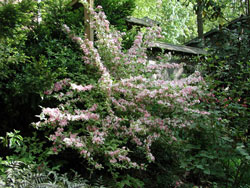Resource Library
Plant of the Week: Weigela
The University of Arkansas System Division of Agriculture does not promote, support or recommend plants featured in "Plant of the Week." Please consult your local Extension office for plants suitable for your region.
Plant of the Week
Weigela
Latin: Weigela florida

To non-gardeners, spring ends when the azaleas finish blooming, but both the calendar and garden tell us it stretches into June. One of the late blooming shrubs that has been around so long many have overlooked it in contemporary gardens is called "old fashioned" - it's Weigela florida.
Weigela is a deciduous shrub growing to 8 feet tall and wide in an arching pile of branches. It belongs to the honeysuckle family. It has a brushy nature with gray-brown branches and in winter has about it a forlorn look.
In most cultivars, the flowers appear with the foliage, making the peak bloom usually in late April to mid-May. Individual flowers are tubular, about an inch long, and borne in small clusters near the ends of branches. Flower color is usually in shades of pink, red or combinations of these suffused with white.
Weigela was one of the deciduous shrubs - along with forsythia, deutzia, mock orange and quince - that dominated Victorian gardens during the latter half of the 19th century. It has been used in Chinese gardens as a hedge plant since at least the third century but was not introduced to the West until 1844 when Robert Fortune, the plant collector sent out by the Royal Horticulture Society in London, saw it in bloom in several coastal cities of southern China.
The plant breeders of France, Belgium and Holland soon began hybridizing the 10 closely related species, flooding gardens with many look-alike clones. During the initial breeding phase, flower display was the principle focus, but since WW II Dutch and Canadian breeders have concentrated more on producing compact plants with showy foliage color to give the plants a longer season of interest. In the past decade, there has been a great increase in interest amongst nurserymen as new, easily grown and colorful foliage forms have appeared.
Of the several hundred Weigela cultivars now listed Bristol Ruby and Red Princess are commonly available reds; Fairy and Boskoop Glory are pink; Candida and Mont Blanc are whites. The old cultivar Variegata has pink flowers and showy yellow and white margined leaves; Variegata Nana is a dwarf form. My Monet is a new compact growing white margined variegated form with wine colored blooms. Wine and Roses has dark burgundy colored leaves.
Weigela is an easy-to-grow plant hardy from zones 4 through 8. It's highly adaptable to almost any soil but is best in full sun. It will still bloom in light shade. Plants bloom on old wood in the spring but many will produce some flowers throughout the summer on new growth. Unpruned plants often develop some dead wood that needs to be removed as soon as noticed to keep the plants tidy.
Weigela is a drab shrub in the winter months so it's best mixed in the shrub border with evergreens to mask some of its winter nakedness. Some gardeners are now using this shrub more for its foliage effect in the summer and are less concerned about bloom production. By periodically shearing it back during the growing season plants can be kept small and the colorful foliage can provide the main display.
By: Gerald Klingaman, retired
Extension Horticulturist - Ornamentals
Extension News - May 15, 2009
The University of Arkansas System Division of Agriculture does not maintain lists of retail outlets where these plants can be purchased. Please check your local nursery or other retail outlets to ask about the availability of these plants for your growing area.